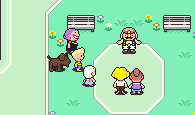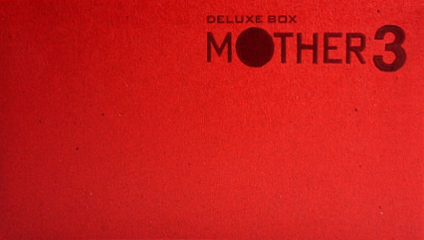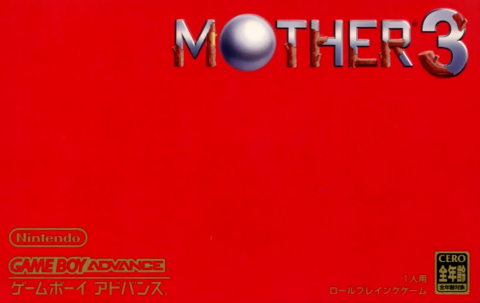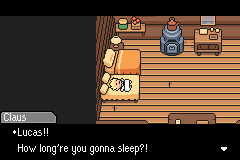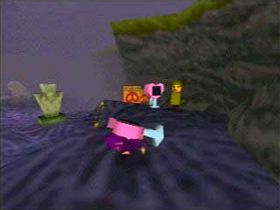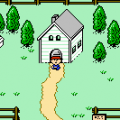Mother 3 was actually highly anticipated by Itoi, and he was already thinking about it back in the early stages of EarthBound development. He wanted to make a sequel so much that he once phoned EarthBound game designer Akihiko Miura in the middle of the night to talk about his idea for the following game, about which the latter was confused enough to simply answer that “it wasn’t time for that”! Actually, that third episode was taken into consideration so early that it was thought it would be released on the Super Famicom CD. Of course, it was soon moved to the Nintendo 64 as a 3D project. And shortly after that, it was decided it would even become of the 64DD’s launch titles. HAL Laboratory, of which Iwata had become the president after EarthBound‘s release, was the only developer left to work on the project, as the APE studio had sort of been turned into Creatures around 1995 to become a developer on the Pokemon series. This didn’t stop some of the former APE members from working on the project though, such as Benimaru Itoh, who contributed concept art.
As early as 1996, the project was already in an advanced state, and what was then called Mother 3: Kikai Seibutsu no Mori (“Strange Creatures Forest”) was already making fans impatient. However, difficulties would soon arise. Of course, this happened with EarthBound as well, but that was a 2D project on an established system – Mother 3, on the other hand, was a 3D project on experimental hardware handled by a team that had no such experience. Iwata’s growing absence caused by his responsibilities on the Dolphin project, the blueprint for the Game Cube, certainly didn’t help. Mother 3 still managed to progress in spite of all and specific 64DD mechanics were even considered for addition, such as an internal clock-based day-night cycle, until it became clear to Nintendo that the 64DD had tanked. The project was then downgraded as a “simple” Nintendo 64 game with an additional Mother 3.5 still envisioned for the 64DD. Somehow, the developers managed to complete a playable demo for the Spaceworld ’99 expo, this time with the definitive title of Mother 3: Butaou no Saigon (for “Fall of the Pig King”). Fans grew even more impatient as the first Super Smash Bros. game in which Ness was featured was released in the meantime. Unfortunately, it would only get worse from this moment on – the release was first delayed to 2000, but failed to appear at the E3 convention of that year. In August, the sad news came out on the Hobonichi: Mother 3 had been cancelled. Years of development hell, budget spending, script writing, event coding… all for nothing. Itoi and Iwata had initially thought about saving the project assets, but they knew it was no use – it would have cost millions of yen, and for what? That was the end of Mother 3.
Screenshots from the cancelled Nintendo 64 version. It does look a bit unconvincing.
After the incident, Mother 3 was never mentioned again for three years. The new Mother content featured in Super Smash Bros. Melee only brought back memories of the sudden halt the series had been forced into. Then, in 2003, Nintendo decided to release a compilation of the two Mother episodes on the Game Boy Advance, only in Japan, as Mother 1+2. It was rather commercially successful, as it sold more than 250,000 copies. There most important thing about this release was a small message left by a Mr. Saturn at the end of TV ad for that half-assed compilation. It read: “We’re working on Mother 3 for the Game Boy Advance, dakota.”
Itoi had been approached for a film or novel adaptation of the cancelled Nintendo 64 project, but he gave up on these possibilities on the ground that he considered Mother 3 to be a video game and nothing else. Pressure from the fans only convinced him further that it was the right decision to make and somehow, the project was revived. This time, the development team was entirely new – HAL Laboratory was only working on the game’s audio through Shogo Sakai, a composer who had worked on series such as Metal Max or Heracles no Eikou but was virtually unknown before he worked on Nintendo titles such as Super Smash Bros. Melee and Kirby Air Ride. The main development was handled by Brownie Brown (now 1-UP Studio), a small studio that was funded by Nintendo in 2000 and composed mainly of former Square employees who had worked on the Seiken Densetsu series. Nobuyuki Inoue, the project’s director, had quite an experience in RPG development: He was the scenario writer and battle designer for LIVE-A-LIVE and handled the maps of Romancing SaGa 3. More recently, he also had directed the Magical Vacation series. In the end, most of Mother 3‘s content would be taken back from the original project and adapted to the new hardware and design. This time, the development actually went smoothly for a change, and the game was completed in less than three years.
Nobuyuki Inoue (director), Shogo Sakai (composer) and Benimaru Itoh (N64 concept artist).
The story take place on Nowhere Islands, an archipelago lost in the middle of nowhere. It is populated by a small rural community, Tazmily Village, which recalls not contemporary America but rather the Old West, with its wooden houses not even connected to electricity. This is where Flint and Hinawa, a lovely couple and parents to a pair of twin brothers called Lucas and Claus, live in harmony with their environment. Indeed, everything was quiet in this isolated land, and society seemed more enjoyable than ever. No money, no war, nothing of the sort – it was nice place to live. But it isn’t long before things begin to get darker – strange events start occurring around this little paradise, commencing with the apparition of men dressed in pig-themed military suits, along with the sudden change in the local animals’ behavior that follow the sound of their marching feet. These occurrences are only the first in a long series of unfortunate predicaments that will change the face of Tazmily forever, like no one could have ever expected.
Characters
Claus – クラウス
The older, red-haired twin brother from Tazmily Village. He’s outspoken, energetic and reckless, and more independent than Lucas.
Flint – フリント
The twin’s caring father, and Hinawa’s spouse. He’s a quiet farmer and primarily tends to his sheep, hence the cowboy outfit.
Hinawa – ヒナワ
The twin’s loving mother, and Flint’s wife. She loves cooking and sunflowers. She’s known through all of Tazmily Village for her kindness and is the very symbol of the town’s peace of mind.
Duster – ダスター
Wess’s good-for-nothing son, with a bad breath and limping leg. He’s been trained to be an ace thief by his father, even though that doesn’t make much sense in a village such as Tazmilly…or does it?
Kumatora – クマトラ
The tomboyish and sailor-mouthed princess heir to the Osohe throne, which she doesn’t seem to care much about. She was an orphan, but was adopted and brought up by the mysterious Magypsies.
Boney – ボニー
Lucas’ and his family’s beloved pet. A brave and intelligent dog, he will actually prove himself to be a worthy fighter in the struggle against the tragedy that will fall upon the Nowhere Islands.
As you can plainly see, a radical change was brought in by the game’s setting. This change is probably what’s going to surprise players the most. It may seem like slippery grounds on which to wander (and it is), but it probably was the best choice they could have made more than ten years after the release of EarthBound.
However, there was an aspect where EarthBound slightly faltered – its gameplay. Of course, it wasn’t bad at all, but it could have used a bit of smoothing out, and this is exactly what Mother 3 does. Indeed, everything has been reworked, starting with the interface. There is no more action prompt, as the menu has been entirely modernized, including the inventory, which clearly needed it. It’s also now possible to run, so wandering around is not only less tiresome, but it also makes the concept of enemy surprises way more exploitable. Moreover, successfully sneaking into an enemy will now start a battle in its back. The HP rolling meter is still present and it’s been reworked as well to roll slower, so people who had a hard time with EarthBound should be relieved. Gameplay-wise, it’s pretty simple: Mother 3 takes everything that had been made before and hones them where they needed it, for the better.
Of course, Mother 3 isn’t content with just updating his predecessor’s gameplay mechanic, adding an interesting twist – a rhythm-based combo system. Every battle music track has a “beat”, which you can reveal by putting the enemy to sleep, or even listening by ear if you’re good enough. And if you press the A button in rhythm with the beat, you’ll chain your attack, up to a 16-hit combo. Most “basic” tracks have a pretty straightforward, metronomic 4/4 time signature which is pretty accessible even when you have to attack with the bass – most of those tracks have more difficult variations, which include rhythmic quirks like unexpected syncopations or tempo changes, sometimes hard enough to make the difficulty go from “subtle” to “John Coltrane”. This combo system is rich but difficult to master, and even musical aficionados will probably break a sweat. But while it makes battles easier, it’s not essential to progress, so you can just forget the combo system if you can’t master it. (And this tends to be a problem if you’re playing on emulators, since the slightly timing differences are often enough to screw up the rhythm totally.) That would be a pity, though – scoring a 16-beats chain on an enemy really makes you feel like a badass.
Beyond the battle system what’s changed the most in this Mother is how the adventure progresses. This time, you won’t get to travel freely across a country passing through towns and all that stuff. Besides, there’s only one town in this game, Tazmily Village. No, this time, the game is way more linear, almost theatric in its unfolding – it’s even divided in eight chapters in which you get to control different protagonists, though Lucas remain the story’s central figure. In the end, you basically go where the scenario simply leads you. It may actually upset a few players, especially those who had appreciated EarthBound‘s eight melodies quest. Here, the progression is way more guided, across an environment that will constantly change while the scenario keeps unfolding. This obviously impacts the world’s structure – there is no town where you can find an hotel to rest or a phone to save – this time, you’ll have to rely respectively on hot springs and frogs that are scattered around Nowhere Island, which assume these functions. (“Give my regards to the next frog you meet”, they happily say.) These new elements also serve as checkpoints of some sort, as this is where you’ll be sent back if you choose to continue after a game over. Your HP and PP will be automatically restored should it happen, so there’s no need for a trip to any hospital of any kind or anything of the sort. This doesn’t make the game easier though, as the difficulty still is pretty well balanced.
The visual quality is still outstanding. This time, the sprites are more detailed than they were in EarthBound while retaining their iconic minimalist, cartoonish look. But more importantly, it’s their animation that make them stand out from the usual 2D character design. It may not feel apparent at first sight, but the attention that was given to these animations gives them a very natural, convincing feel that has more influence than one may expect on the way the NPCs impact the player. Sometimes, the mere way a character turns around has a very specific and surprising feel, but the polishing of what seems like insignificant details is also how a Mother game can be recognized.
The humor is still inseparable from the game’s universe. It’s not really centered around parody and pop culture anymore, particularly due to the change in setting, but this rightly allows for a breath of fresh air. Most of the wit is derived from the the specific reactions expressed by the different characters in face of the unsettling events that are affecting Nowhere Islands. Sometimes, though, the laughter is hollow, and some other times, there’s actually no laughter at all. Indeed, one of the game’s most striking turns can be felt clearly from the start: The experience is largely centered around emotions. Of course, the first Mother game’s slogan was “No crying until the ending”, but this time, it really is what the game bases itself on. The scenario will make you go through a sentimental whirlwind that was pretty much unsuspected due to the game’s visual minimalism… but, once again, this blending of intentional simplicity and almost immeasurable narrative complexity is what makes a Mother game, and it couldn’t have been truer than with Mother 3.
The notion of a “sad” game entails another storytelling stance – that the game is also more “serious”. And Mother 3 is indeed, quite clearly, the darkest of the series. It’s the only episode in which there are genuinely moving sequences and real character developments, which focus on the protagonists’ fears and uncertainties that arise in the midst of Tazmily’s mutating world . Of course, that Mother 3 is more “serious” doesn’t mean it takes itself too seriously or tries too hard to be dark – it’s very natural, with its own bizarre quirks. What is touching in Mother 3‘s storyline is the chain of unnerving and almost ridiculous tragedies wrecking Nowhere Islands, often with a touch of dark humor that starts as soon as Bronson uttered his infamous line: “Flint, I have good news and I have bad news.” Mother 3‘s focus on emotional storytelling may indeed feel a bit more “classical” and less “insane” than EarthBound‘s existential-psychedelic metaphysics as a result. In the end, though, it’s still a Mother game, and “classicism” in such a context still means “unabashed surrealism” in comparison to the common RPG. Mother 3 just walks another path to establish its depth.
This path the game has chosen to walk is that of reflection and analysis. The adventure takes place in a world caught up in a bizarre yet very real mutation. At the start of chapter 4, after the scene has been successfully set, an ellipse brings the player three years later, to an unrecognizable Tazmily that once was a small utopian rural village and now has gone through a radical transformation process. Of course, there already exists a whole bunch of “anti-consumerist” works, and the like in every medium, most of which really aren’t all that subtle. But that is not where Mother 3 stands. This contributes to a most welcomed absence of phony black-and-white morality-tainted “sides” in the story, and it helps in reasserting every last NPC’s humanity in this open-minded yet unsettling atmosphere where you are to expect anything coming from the disorientated citizens of the new Tazmily, from desperate bravery to aggressive conformism.
“Those thoughts of endless improvement are a display of self-denial. After all, what is “good” and what is “bad” changes depending on the situation. On top of that, there might be some people out there with dangerous thoughts, like, “in order to make the world a better place, I am going to kill you”. Take war, for instance. Isn’t that what it’s all about?” – Shigesato Itoi
The whole series has been characterized by its lack of posturization and its humorous detachment, and to keep true to this creed was a requisite for a work that chose to deal with such topics not to end up running in circles or stating the obvious. In spite of its emotional storytelling and confusing chain of senseless tragedies, Mother 3 managed to keep a somewhat light-hearted tone. The game’s slogan states that the game is both strange and funny, but that it turns out to be heartrending afterwards. It perfectly fits the emotional roller coaster that is Mother 3, as the “heartrending” feeling could refer to its weird sadness as much as to its gentle melancholy. But if emotion and reflection goes hand-in-hand so well in this game, it’s in great part thanks to its propensity to leave the interpretation to the player. You are thus free to play Mother 3 as a deconstruction of innocence, a rereading of the fall of utopias, a proof of technology’s lack of neutrality, a journey through human nature, a display of post-industrial society’s contradictions, or anything else really, it’s your own vision that counts. It is clearly not over-analysis ; this rich reflection is permitted by the game’s very content and principles. In a lot of games and other pieces of fiction, speculation often starts with “how”. In Mother 3, it mostly starts with “why”.
“My personal feelings steer me to want to affirm everything the player thinks about the game. I wanted to make Mother 3 like a mirror. One that reflects the heart of the player off of the screen…Mother 3 is a playground with plenty of room for your imagination to run free. The more you think about it, the greater Mother 3 will become. The more you feel it, the deeper it will become. The more fun you have, the more you’ll grow.” – Shigesato Itoi
This new, intriguing world needed a fitting soundtrack, just like its predecessors. The soundtrack basically needed to be on par with that of EarthBound quality-wise, which is quite an achievement. Especially since Tanaka and Suzuki didn’t return on this one – the one who was tasked with the game’s music was the way less experienced HAL composer Shogo Sakai, who had nowhere near as much involvement in alternative music as the two other guys did back then. On top of that, he had to work on the Game Boy Advance, whose audio is infamous for its very limited capabilities. And yet, his work is truly remarkable. The series couldn’t have hoped for a better musical conclusion. It’s true it’s less experimental in nature than that of EarthBound (it could hardly have been MORE though), but it still manages to draw inspiration from its peculiarity and variety to create something new. While the terribly poignant Love Theme definitely has an Eight Melodies-like feel, Mother 3‘s music has a funky side to itself that wasn’t really present before, and it is powered by what probably is the handheld’s most unexpectedly impressive sound font. The blending of Latin music with synth and string bass as well as the oscillation between acoustic guitar and electronic pads contribute in the creation of a peculiar aesthetic that perfectly fits Tazmily’s mutating atmosphere. Sakai also proved to be as prolific as his illustrious predecessors, producing more than twenty tracks for battle music alone, not including their “hard” variations. Mother 3‘s music is worthy of its legacy.
“Sakai wasn’t competing with the composers of EarthBound. He was instead competing with their fans, to which the music of Mother and EarthBound is a kind of immortalized perfection. Dealing with that as competition is really tough. And Sakai had to deal with that battle all on his own….I had to assign the music to someone in the development team, someone who understood the game the most.” – Shigesato Itoi
This is where everything comes to an end. It’s true some of the changes may upset EarthBound fans a little, but that doesn’t stop the adventure from being a distinctive, extraordinary journey resourceful enough to leave a lasting mark on the player. It’s a bit hard to explain Mother 3‘s depth without resorting to spoilers, so just go and play it, and share the experience with your friends. You’ll probably find an additional dimension to the game that way: Remember that it is when games are conveyed that they start to really make sense.
Mother 3 was thus miraculously released on April 26, 2006. That basically makes its development time the longest in history, since it took ten years for the game to eventually see the light of day. The game was so long-awaited it reached pre-order records, including for its limited-edition Deluxe Box which contained a Game Boy Micro, a Mother-themed faceplate and a Franklin Badge. The sales indeed proved the series was still popular, as they reached 400,000 copies like the first episode did back in its time. Reviews were mostly positive, but somehow the reception remains mixed overall in Japan. It seems a lot of Japanese gamers ended up really disliking the game, apparently due to its change of focus when compared to its predecessor. The game has its numerous defenders anyway, who acknowledge the game had a different feel to EarthBound but still found it to be a very compelling experience. However, that wasn’t the most upsetting part about Mother 3‘s release. Nintendo decided not to localize the game in spite of the drama this decision caused overseas, against which numerous petitions and campaigns proved unsuccessful.
“It’s both strange and funny, but then it also gets heartrending.”
(Kimyou de, omoshiroi. Soshite, setsunai.)
No official reasons were ever given for that decision. Some postulate it may have had to due with lingering resentment over the failure of EarthBound when it was released on the SNES a decade before. Other theories suggested that the dark overtones meshed with the cutesy graphics would not go over with the Game Boy Advance audience, a system typically thought of for children. Other thematic concerns included the fact that the game includes a troupe of transvestites, or that the vaguely anti-capitalist themes could be construed as an endorsement of the ever-evil communism. However, the most likely reason for Mother 3 never to be release outside of Japan is probably mainly economic concerns over a title that came out so late in the console’s lifespan, actually even after the Nintendo DS was released. The fact that Nintendo of America’s effort to localize Namco’s Tales of Phantasia and Game Freak’s Drill Dozer met with poor commercial success certainly didn’t help, and this was also probably the cause why the first episode of Rhythm Tengoku ended up never being localized either.
Coming from the perspective of an English-speaking EarthBound fan, this seemed outrageous, as the community long expressed unbridled amounts of enthusiasm over at websites like Starmen.net. That’s when some Western fans decided to take the issue into their own hands: In 2007, when it became clear the game would never be released outside of Japan, highly popular Starmen.net fansite co-founder and professional translator Tomato decided to start an ambitious project – no less than a complete, high-end translation for Mother 3. It would mobilize a whole team of hard-working translators and hackers for more than one year, and a patch was finally released on October 17, 2008. The result was so flawless that even industry figures including but not limited to Nintendo employees lauded their colossal achievement. It’s an amazing translation that keeps true to the spirit of the localization of the SNES EarthBound, and could easily pass as an official product. Western Mother enthusiasts can now main Lucas on Super Smash Bros. Brawl with an easy conscience thanks to this effort. Fans even went as far as to produce an unofficial guide, complete with old-school clay models. In 2013, when Nintendo began to announce wider support for Game Boy Advance titles on the assorted Virtual Console platforms, Tomato even offered to supply his translation for free, should Nintendo of America ever decide to release it officially. As of this writing, no decision has been made, but here’s hoping Nintendo makes the wise decisions and brings Mother 3 to the wider audience it deserves.
A series such as Mother couldn’t have ended with a better conclusion. A conclusion indeed, as Itoi has stated numerous times in interviews that he didn’t plan on making a sequel: He considers the series to be over, in the sens of “accomplished” – he’s got fond memories of the series’ production and even greater fondness towards the players who enjoyed his games. “I’m sure it’s the same with any product or work of creativity: In the very end, it’s the customer or end user who finishes it for you.” Indeed, the Mother series was a very peculiar experience, where the player and the game designer have never been so strangely close together through the game’s weird design. Which lead us to Itoi’s consideration on a potential sequel: “If there was a Mother 4, I’d like to be the player.” A request that has been sort of answered, since said sequel is in development as a fan game since 2008.
This is where eventually ends the story of the Mother series, one of if not the most unique video game series… no, work of Art ever produced. Itoi’s now famed brainchild, which managed to make entire generations shed endless tears and feel completely confused for no less than 17 years of pure… Mother-ness has rightfully entered the Hall of Fame of video game art, occupying its very own spot far from the other classics. In spite of all the trouble it went through, it was a distinctively wonderful experience.
Ochikondari mo shita kedo, watashi wa genki desu.
I’ve had hard times, but I’m well.

